Dynamic expression of Lgr5, a Wnt target gene, in the developing and mature mouse cochlea
- PMID: 21472479
- PMCID: PMC3123443
- DOI: 10.1007/s10162-011-0267-2
Dynamic expression of Lgr5, a Wnt target gene, in the developing and mature mouse cochlea
Abstract
The Wnt signaling pathway is a recurring theme in tissue development and homeostasis. Its specific roles during inner ear development are just emerging, but few studies have characterized Wnt target genes. Lgr5, a member of the G protein-coupled receptor family, is a Wnt target in the gastrointestinal and integumentary systems. Although its function is unknown, its deficiency leads to perinatal lethality due to gastrointestinal distension. In this study, we used a knock-in reporter mouse to examine the spatiotemporal expression of Lgr5 in the cochlear duct during embryonic and postnatal periods. In the embryonic day 15.5 (E15.5) cochlear duct, Lgr5-EGFP is expressed in the floor epithelium and overlapped with the prosensory markers Sox2, Jagged1, and p27(Kip1). Nascent hair cells and supporting cells in the apical turn of the E18.5 cochlear duct express Lgr5-EGFP, which becomes downregulated in hair cells and subsets of supporting cells in more mature stages. In situ hybridization experiments validated the reporter expression, which gradually decreases until the second postnatal week. Only the third row of Deiters' cells expresses Lgr5-EGFP in the mature organ of Corti. Normal cochlear development was observed in Lgr5(EGFP/EGFP) and Lgr5(EGFP/+) mice, which exhibited normal auditory thresholds. The expression pattern of Lgr5 contrasts with another Wnt target gene, Axin2, a feedback inhibitor of the Wnt pathway. Robust Axin2 expression was found in cells surrounding the embryonic cochlear duct and becomes restricted to tympanic border cells below the basilar membrane in the postnatal cochlea. Both Lgr5 and Axin2 act as Wnt targets in the cochlea because purified Wnt3a promoted and Wnt antagonist suppressed their expression. Their differential expression among cell populations highlights the dynamic but complex distribution of Wnt-activated cells in and around the embryonic and postnatal cochlea.
Figures

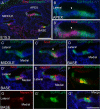


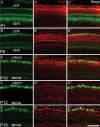

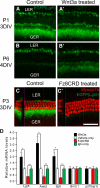
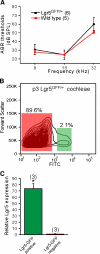
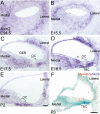
Similar articles
-
Unidirectional and stage-dependent roles of Notch1 in Wnt-responsive Lgr5+ cells during mouse inner ear development.Front Med. 2019 Dec;13(6):705-712. doi: 10.1007/s11684-019-0703-y. Epub 2019 Oct 8. Front Med. 2019. PMID: 31598881
-
Wnt signaling induces proliferation of sensory precursors in the postnatal mouse cochlea.Proc Natl Acad Sci U S A. 2012 May 22;109(21):8167-72. doi: 10.1073/pnas.1202774109. Epub 2012 May 4. Proc Natl Acad Sci U S A. 2012. PMID: 22562792 Free PMC article.
-
Dynamic expression of Lgr6 in the developing and mature mouse cochlea.Front Cell Neurosci. 2015 May 12;9:165. doi: 10.3389/fncel.2015.00165. eCollection 2015. Front Cell Neurosci. 2015. PMID: 26029045 Free PMC article.
-
Wnt signaling during cochlear development.Semin Cell Dev Biol. 2013 May;24(5):480-9. doi: 10.1016/j.semcdb.2013.03.008. Epub 2013 Mar 30. Semin Cell Dev Biol. 2013. PMID: 23548730 Free PMC article. Review.
-
The Lgr5 transgene is expressed specifically in glycinergic amacrine cells in the mouse retina.Exp Eye Res. 2014 Feb;119:106-10. doi: 10.1016/j.exer.2013.11.003. Epub 2013 Nov 15. Exp Eye Res. 2014. PMID: 24246263 Free PMC article. Review.
Cited by
-
Stem Cell-Based Therapies in Hearing Loss.Front Cell Dev Biol. 2021 Oct 21;9:730042. doi: 10.3389/fcell.2021.730042. eCollection 2021. Front Cell Dev Biol. 2021. PMID: 34746126 Free PMC article. Review.
-
LGR5-Positive Supporting Cells Survive Ototoxic Trauma in the Adult Mouse Cochlea.Front Mol Neurosci. 2021 Oct 5;14:729625. doi: 10.3389/fnmol.2021.729625. eCollection 2021. Front Mol Neurosci. 2021. PMID: 34675775 Free PMC article.
-
Characterization of Lgr6+ Cells as an Enriched Population of Hair Cell Progenitors Compared to Lgr5+ Cells for Hair Cell Generation in the Neonatal Mouse Cochlea.Front Mol Neurosci. 2018 May 14;11:147. doi: 10.3389/fnmol.2018.00147. eCollection 2018. Front Mol Neurosci. 2018. PMID: 29867341 Free PMC article.
-
Junctional E-cadherin/p120-catenin Is Correlated with the Absence of Supporting Cells to Hair Cells Conversion in Postnatal Mice Cochleae.Front Mol Neurosci. 2018 Feb 21;11:20. doi: 10.3389/fnmol.2018.00020. eCollection 2018. Front Mol Neurosci. 2018. PMID: 29515364 Free PMC article.
-
Characterization of Lgr5+ Progenitor Cell Transcriptomes after Neomycin Injury in the Neonatal Mouse Cochlea.Front Mol Neurosci. 2017 Jul 4;10:213. doi: 10.3389/fnmol.2017.00213. eCollection 2017. Front Mol Neurosci. 2017. PMID: 28725177 Free PMC article.
References
Publication types
MeSH terms
Substances
Grants and funding
LinkOut - more resources
Full Text Sources
Other Literature Sources
Molecular Biology Databases
Miscellaneous

